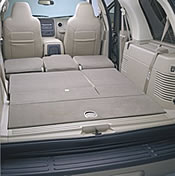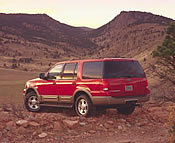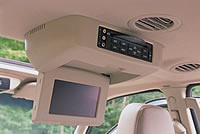|
|
A
Rugged Redesign
The 2003 Ford Expedition
By
Martha Hindes
 It's
big, it's bold and some say it's brash. And that's without driving
it. It's
big, it's bold and some say it's brash. And that's without driving
it.
Whatever
the "B" word, one thing is certain. Ford's next generation,
full-size Expedition won't get lost in the crowd. Ford had a chance
to make some serious points when it was time for a total revamp of its
four-door sport utility king and, if first impressions count for anything,
it appears they succeeded.
The new
Expedition to be launched in late Spring as a 2003 model hasn't been
tamed that much. Its heart is solid off-roader -- rugged, tough, with
practical and good looking cladding and slightly-raised hoodline. It's
designed for the kind of presence that could intimidate a lesser sport
utility pretender out of the passing lane. (Anyone who's ever had a
semi-truck crowding the rearview mirror should appreciate that aspect.)
But underneath
such shoulder-bumping ruggedness is an extremely practical and genuinely
refined vehicle with touches of pure luxury thrown in for good measure.
This time someone up in Ford's stellar design studio was paying attention
to what drivers really want to make life a lot easier and more comfortable.
Take the
third row of seats, for example. Check out the competition in the full-size
SUV class, and there's a real problem if you plan to pack in a few sets
of skis or a ton of luggage for an extended cross-country drive, far
from the hassle of an hours-long airport check-in line. It's no fun
trying to flop excess baggage over the rear row seatbacks or stack it
until it blocks the rear window.
During
test drives in most full-size SUVs in the past, I've simply bypassed
the idea of wrestling those seats out of their sockets to store wherever
until I needed them again. Somehow the idea of hoisting a bulky carseat
weighing what feels like a couple of hundred pounds (and not wanting
to stash it inside my office for safekeeping in the process) simply
didn't seem worth the effort. You can run out of willing coworkers and
friends in a hurry when you ask them for that kind of help.
But (sigh
of relief), not so with the new Expedition. Instead of removable
seats, the Expedition's third row simply folds down with the touch of
a button just inside the rear liftgate, leaving a flat, level floor
in its place.
 Sales
kits, computers, luggage, the spoils of a successful antiquing foray
or even a mountain bike all promise to slide in easily as soon as the
second and third row seats fold down flat, opening up 110.4 cubic feet
max of cargo space. And you don't need a garage for leftover seats when
it's time for some serious traveling. For a night out with several friends,
the two power-fold buttons raise up the split back third row in a moment.
The electronic gizmo is optional and is only available on the upscale
Eddie Bauer model. But what the heck, it can't be that difficult to
raise and lower those fold-flat rear seats by hand, can it? Sales
kits, computers, luggage, the spoils of a successful antiquing foray
or even a mountain bike all promise to slide in easily as soon as the
second and third row seats fold down flat, opening up 110.4 cubic feet
max of cargo space. And you don't need a garage for leftover seats when
it's time for some serious traveling. For a night out with several friends,
the two power-fold buttons raise up the split back third row in a moment.
The electronic gizmo is optional and is only available on the upscale
Eddie Bauer model. But what the heck, it can't be that difficult to
raise and lower those fold-flat rear seats by hand, can it?
Roominess
and Safety Features
The
inside of this SUV is spacious enough to carry nine, if the first and
second row captain's chairs are bypassed for benches. But it seems roomy
no matter where you sit. I watched a six-foot-tall male do a third-row
stretch with no awkward pretzel legs nearly touching his chin and without
bumping his head on the roof. Shorter drivers shouldn't have distance
complaints either when trying to reach controls. Thanks to the standard,
power-adjustable pedals there's no more nose to the steering wheel for
the less-than-stately.
Should
the unthinkable rollover accident occur, Ford has developed an aggressive
Safety Canopy system. In addition to steel safety beams inside the doors,
there's an optional side curtain airbag the full length of each side.
It stays inflated for as long as six seconds, enough for a vehicle to
complete repeated tumbling revolutions (if an accident is that severe).
Another
safety option I strongly recommend: Tire pressure monitors to check
inflation on the larger, 17-inch Continental tires to prevent blowouts
or worse. I'm not the only one who has been lax about checking for proper
tire pressure every month -- a critically important accident prevention
measure.
Ford has
tweaked two V-8 engines for its new contender, a Triton-based 4.6-liter
aluminum block and its mainstream 5.4-liter Triton with cast iron engine
block (applications chosen for their strength and ability to mute out
annoying noise). The 5.4-liter pumps out 260 horsepower at 4,500 rpm
and 350 lb-ft of torque for more off-road or towing "oomph."
All those
complaints that circulated about such a high profile vehicle's brutish
advantage in a collision could be but a bad memory for the new Expedition.
Bumper beams fixed at passenger car level are hidden under bumper fascia
covers that visually wrap into the cladding line and replace the high-set
chrome behemoths of the past. That's safety in a nattier package.
Bragging
Rights
 This
was a total redesign for Ford with virtually nothing left over from
the previous generation Expedition except some hardware in the front
seat doors. Nothing, say its engineers, was left to chance. It's easy
to tell the importance of the new Expedition to the company by the amount
of pre-inaugural press material it distributed. While trumpeting it
as "The best in snow, the best in dirt," and of course the
best on the road, it gave minute detail about every aspect of the redesign:
Structural foam used to quiet the cabin and stiffen the chassis for
strength. The added safety of its ControlTrac four-wheel-drive. A 20
percent shorter stopping distance during emergency braking. An optional
AdvanceTrac anti-slip stability system to prevent sliding on slick road
curves. Plus more. This
was a total redesign for Ford with virtually nothing left over from
the previous generation Expedition except some hardware in the front
seat doors. Nothing, say its engineers, was left to chance. It's easy
to tell the importance of the new Expedition to the company by the amount
of pre-inaugural press material it distributed. While trumpeting it
as "The best in snow, the best in dirt," and of course the
best on the road, it gave minute detail about every aspect of the redesign:
Structural foam used to quiet the cabin and stiffen the chassis for
strength. The added safety of its ControlTrac four-wheel-drive. A 20
percent shorter stopping distance during emergency braking. An optional
AdvanceTrac anti-slip stability system to prevent sliding on slick road
curves. Plus more.
Ford touts
the Expedition"s "more athletic image." But if it indeed
has been to the fitness center, then you might say the interior has
been to a spa. There's no hint of its earlier pickup truck heritage
inside. The subtle two-tone interior (sand in the prototype) is lighter
on top for a calming sense of spaciousness, and a few tones darker at
wear areas to hide the inevitable usage. Gone are glaring chrome accents.
Instead, there are touches of muted satin-finished steel, elegantly
understated without being bland. A softened Nebo leather is standard
on the upscale Eddie Bauer version and optional on the XLT.
 Among
some tonier upgrades are a video navigation system and a sonar/radar
backup guide to search out objects behind the vehicle for a range of
20 feet. The large center console can swallow up a laptop computer.
And the DVD entertainment screen uses an infrared remote, so even those
in the third row can punch in a choice without punching out a sibling
to do it. Among
some tonier upgrades are a video navigation system and a sonar/radar
backup guide to search out objects behind the vehicle for a range of
20 feet. The large center console can swallow up a laptop computer.
And the DVD entertainment screen uses an infrared remote, so even those
in the third row can punch in a choice without punching out a sibling
to do it.
Ford added
a gentle touch for women with small children or grandchildren. The available
second-row bench seat has a 40-20-40 split. The small middle seat moves
forward 11 inches to bring an infant or toddler within monitoring reach
without needing to turn around to look.Pricing
isn't yet available for the new Expedition. But with last year's 4X4
model starting in the $35,000 price range, and overall vehicle prices
holding or lowered with near-record rebates and incentives, it's doubtful
it will provide much sticker shock in comparison.The prototype
that previewed in January, well before the availability of test vehicles
to drive, left little doubt the Expedition should be a winner in its
category when it actually gets out on the road. For now, based on appearances
alone and assuming it lives up to its pre-launch billing, it could be
a pretty tough act to follow.
To "Boldly Go" -- Just about Anywhere
|
A funny thing happened on the way to Vancouver. I fell in love with
a great big, full-size, own-the-road sport utility vehicle. I
approached the venture knowing what Ford's totally redesigned
2003 Expedition was supposed to be about. But now, as I guided
it along a twisting mountain road that snaked close to sheer mountain
walls and skirted thousand foot dropoffs, I realized it wasn't
hype, it was real.
Critics
complain the best of full-size SUVs are still a lumbering lot,
meant for workhorse towing or to stroke needy egos, but with little
other purpose for most who drive them. I beg to differ. Granted,
the Expedition isn't exactly petite -- a necessity if you're carrying
loads of people or stuff -- but behind the wheel its size is soon
forgotten.
Ford
gave me a primed-with-confidence chance to find out just what
Expedition is all about, with a trek through Canada's Coastal
Mountains in British Columbia that ended at the edge of the Pacific.
The two days of driving encompassed slick wet roads, snowy trenches,
iced gravel, a sea of mud navigated without getting stuck and
some of the most challenging two lane highways ever carved out
of solid granite.
You'd
expect to feel tentative on a road where the longest straightaway
between hairpin curves is a few hundred yards at best. But within
minutes of taking the wheel, it feels like you're driving a car.
As miles melt away, so does any question about the Expedition's
capabilities. Instead, you learn to trust the vehicle and enjoy
the breathtaking view.
My
drive was meant to push limits, aggressively adding speed and
testing cornering as the Expedition loped along. Even lead-footed
driving left no sense of sway, no hint of fishtailing, no fight
to keep steering under control. Response from the 5.4 liter Triton
V-8 engine was instant during a tight passing maneuver. The feeling
was solid as it took curve after curve with ease and comfort --
and with a surprisingly small appetite for fuel.
Ford
had hinted its new generation Expedition with unique fold flat
rear seating wouldn't break the budget. Base prices remain about
the same as 2002 models -- ranging from $31,295 for the XLT's
value model to $41,935 for the premium Eddie Bauer series plus
$740 destination and delivery when it actually goes on sale this
summer. It's clear the company has kept its word.
Would
I want to drive the Expedition again? You bet. Just hand me the
keys and hope you can pry them loose when I'm done.
--Martha
Hindes
|
|